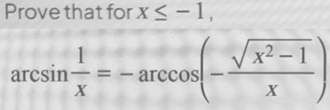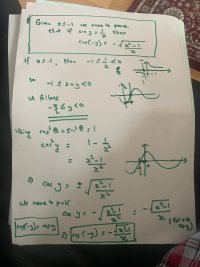You are using an out of date browser. It may not display this or other websites correctly.
You should upgrade or use an alternative browser.
You should upgrade or use an alternative browser.
Inverse Trig Problem: Prove arcsin(1/x) = -arccos((sqrt{x^2 - 1})/x)
- Thread starter apple2357
- Start date
What i have tried so far:
siny =1/x and cos y = - sqrt(1-1/x^2)
Then i am thinking there are conditions on siny and cosy which would lead to inequalities:
-1<=siny<=1 which leads to -1<=1/x<=1
and similarly for the cos y expression
And this is where i get stuck
I am also thinking of using the Pythag. identity ( sin squared + cos squared =1) but not sure where that leads to anything useful.
These are my thoughts so far but i would appreciate a hint of some sort please?
Thanks
siny =1/x and cos y = - sqrt(1-1/x^2)
Then i am thinking there are conditions on siny and cosy which would lead to inequalities:
-1<=siny<=1 which leads to -1<=1/x<=1
and similarly for the cos y expression
And this is where i get stuck
I am also thinking of using the Pythag. identity ( sin squared + cos squared =1) but not sure where that leads to anything useful.
These are my thoughts so far but i would appreciate a hint of some sort please?
Thanks
Please offer your thoughts - so that we know where to begin?Can anyone offer any thoughts on this problem please?
Did you try substitution?
Last edited:
Dr.Peterson
Elite Member
- Joined
- Nov 12, 2017
- Messages
- 16,087

Well, we don't know that both sides are equal; we want to prove they are. So you can't take this as given.What i have tried so far:
siny =1/x and cos y = - sqrt(1-1/x^2)
But you're right that we want to show that, if sin(y) = 1/x, with x <= -1, then cos(-y) = -sqrt(x^2-1)/x, and the red negative can be dropped.
I would immediately think about quadrants as well: Where must our angle y be?
Then I'd draw a triangle with angle y, and fill in sides. (If you prefer, you can use this just to guide your thinking about Pythagoras.)
Finally, I'd make sure the RHS is in the right quadrant.
That's basically what he's doing, but calling the angle y.If I were to solve this problem, I would substitute
x = sec (Θ)
Ok, i have had a go: If anyone can check it over i would be grateful. The tricky bit is knowing which cos y to pick and i think i can justify it, but would prob fail under intense interrogation. I think we would pick the negative sqrt because we need to cos y to be positive?
Attachments
Dr.Peterson
Elite Member
- Joined
- Nov 12, 2017
- Messages
- 16,087
You found that y is in quadrant IV. What quadrant will -y be in? Therefore, what is the sign of cos(-y)?I think we would pick the negative sqrt because we need to cos y to be positive?
On the other hand, given the sign of x, is it really true that [imath]\sqrt{x^2}=x[/imath]?



